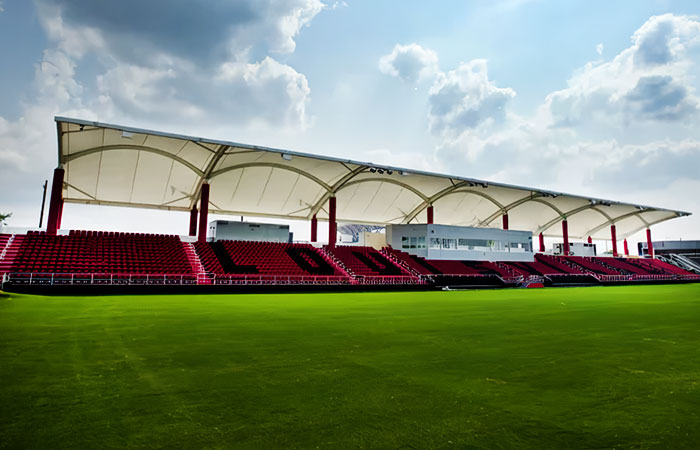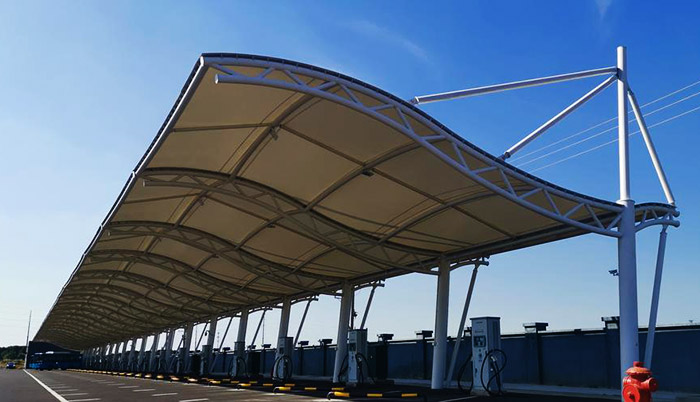What are the uses and advantages of tensile structures?
Tensile structure is a lightweight fabric structure that uses tension to carry loads. With its unique shape and excellent performance, it has been widely used in many fields. With its light weight, high efficiency, and flexibility, it not only provides architects with greater creative space, but also brings more convenience and comfort to our lives. Tensile fabric structures are commonly used in transportation facilities, construction, and other applications that require a high degree of sustainability and aesthetics. They can also be used as lightweight alternatives to steel frames in applications such as skyscrapers, playground shade structures, garden shade structures, etc.
The design of tensile structures can vary depending on the needs of a specific project. They are often used to provide shade or shade to buildings. The beauty of tensile structures makes them an attractive choice for many types of facilities. They also offer a unique combination of reliable functionality and aesthetic appeal. These advantages make them very popular structural systems.

What are the uses of tensile structures?
In large sports venues, tensile structures are often used as roofs. Its unique shape and light texture not only add a modern feel to the venue, but also effectively meet the needs of lighting and ventilation. In exhibition halls and conference centers, tensile structures are often used as sunshades or canopies to provide a comfortable environment for visitors and attendees. In addition, tensile structures are also widely used in temporary facilities, landscape architecture, membrane structure parking sheds and other fields, demonstrating their wide adaptability and practicability. Tensile structure can be used to create prefabricated modular buildings or as lightweight elements of existing structures. They are one of the most cost-effective options on the market. Tensile fabric structures can be very durable if designed and constructed properly.
Tensile structure is more cost-effective than tensile fabric structure and uses less material. Tensile structures can create entire buildings, making them the first choice for complex design work. Tensile fabric structures are usually made from thin fabrics that are stretched in opposite directions to create a double curvature. The double curvature doubles the stiffness of the fabric. Tensile structures can span long distances without the need for intermediate supports.

Advantages of tensile structures
- Tensile structures are lightweight. Due to the use of high-strength flexible materials such as steel cables and membrane materials, tensioned structures are lighter in weight than traditional concrete structures or steel structures, reducing the requirements for foundations and reducing material consumption.
- Tensile structure is highly efficient. Through reasonable tension and support design, the tension structure can achieve efficient force transmission and dispersion, making the entire structure evenly stressed and improving the stability and load-bearing capacity of the structure. At the same time, due to its lightness, tensioned structures have better earthquake and wind resistance in response to natural disasters such as earthquakes and wind disasters.
- Tensile structures also have the advantages of diverse forms and flexibility. Designers can create various unique forms and spatial effects by adjusting the tension and the position of support points according to needs. This flexibility allows tensile structures to be more creative and imaginative in architectural design.
- Tensile structures are also environmentally friendly. Due to its high material utilization rate, light weight, and short construction period, the tensioned structure can reduce energy consumption and environmental pollution during the construction process, which is in line with the concept of sustainable development.

To sum up, the tensile structure has shown great potential and value in the construction field due to its advantages such as lightweight, high efficiency, diverse forms and environmental protection. With the continuous advancement of science and technology and changes in people’s aesthetic concepts, I believe that tensile structures will be more widely used and promoted in the future, creating more beautiful and practical architectural works for us.